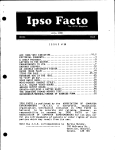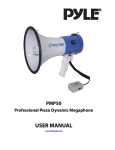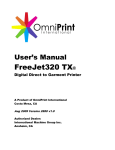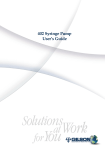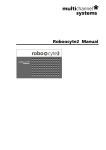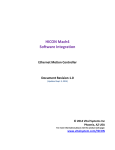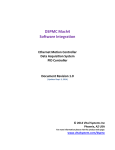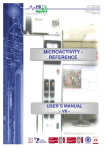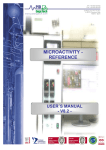Download Appendix B: Computer Remote Command Protocols
Transcript
Appendix B: Computer Remote Command Protocols Introduction Any computer with an RS-422 serial interface port can be used to control the Rainin RP-1 Peristaltic Pump. Interface adapters are commercially available to convert RS-232 ports to RS-422. Software for controlling the RP-1 from an external computer must use specific RS-422 protocols, described in the following paragraphs. Description The RS-422 bidirectional communications channel allows the computer to communicate with up to 64 slave devices with unique unit ID numbers, designated as units 0 through 63. The computer communicates with one pump at a time by transmitting the pump’s unit ID. The pump which recognizes the unit ID connects to the channel, and any other selected device disconnects. Physical Connections All connections are made with 9-pin sub-miniature D-connectors and cabling as shown in Figure 1. PUMP COMPUTER 1 1 RESERVED 1 1 6 6 RESERVED 6 6 OUT - 2 2 2 2 IN - OUT + 7 7 7 7 IN + IN - 3 3 3 3 OUT - IN + 8 8 8 8 OUT + CLOCK IN - 4 4 4 4 CLOCK OUT - CLOCK IN + 9 9 9 9 CLOCK OUT + 5 5 RESERVED 5 5 M F 9-CONDUCTOR FLAT CABLE #28 AWG, 0.050 SPACING M F Figure 10: RS-422 SIgnal Lines CONNECTORS ARE 9-PIN SUBMINIATURE D-TYPE Data Format Data communication is asynchronous, eight-bit, even parity, consisting of one start bit, eight data bits, one parity bit and one stop bit. RP-1 pumps check for even parity and use even parity when replying. Parity error causes the pump to disconnect from the RS-422 channel. This can be corrected by reconnecting then restarting the message. Baud rates Baud rates are: 600, 1200, 2400, 4800, 9600 and 19200. The clock will run at 16X the baud rate. RP-1 pumps operate at 600 baud with their internal clocks. If no clock signal is supplied, the pump will communicate at 19200 baud. 21 Connect/ Disconnect Sequence Before connecting to a particular pump, the computer must first send a disconnect code (255 - FF hexadecimal). The computer waits 20 milliseconds to allow any active device to turn off its driver. Then the computer sends the desired pump’s unit ID number as an eight-bit byte with the most significant bit set (add 128 to the unit ID number). The pump that recognizes the unit ID connects its transmitter to the communications channel and echoes the unit ID. Any device which does not recognize the unit ID will disconnect. The active pump will echo its unit ID within 20 milliseconds after receiving it — if no response is received in that time, the computer may assume the pump is unavailable. The selected pump remains connected until the disconnect code or the unit ID of another device is received. The connect/disconnect flow chart is shown below. START DISCONNECT ALL DEVICES 20 MS DELAY SEND SELECTED UNIT ID NUMBER N 20 MS TIMEOUT ? UNIT ID ECHOED ? N Y Figure 9: Connect/ Disconnect Sequence Commands ERROR HANDLER Y SELECTED DEVICE IS CONNECTED Two types of commands can be sent via the RS-422 channel; buffered and immediate. Buffered commands are instructions, and are executed as background processes. Immediate commands are status requests, and are given a higher priority. The RP-1 will interrupt a buffered command to respond to an immediate command. Immediate commands are single-letter status requests with immediate priority. Buffered commands will be interrupted to complete an immediate command. Immediate commands (from the following RP-1 set:) can be any valid data character except the following: 1 2 3 4 22 line-feed (0A hexadecimal) carriage return (0D hexadecimal) pound sign (23 hexadecimal) or NAK (15 hexadecimal) Immediate commands return messages of one or more characters. Each character must be sent within 20 milliseconds after the command character has been transmitted. The first character is sent as a response to the command. The computer gets additional characters in response by sending an ACK (6 hexadecimal). The last character of an immediate command has its most significant bit set to 1. The host computer will not “ACK” it. Buffered commands consist of an ASCII string of one or more characters preceded by a line feed <LF> (0A hexadecimal) and followed by a carriage return <CR> (0D hexadecimal). The pump echoes with a line feed <LF> if ready for a command and with a pound sign <#> (23 hexadecimal) if not ready. If not ready, the computer retries sending the line feed until the pump echoes a line feed. Once the pump echoes the line feed, each subsequent character will be echoed if there is no error. If there is an error, no echo will be made and the pump will disconnect from the channel. If the computer is checking echoes and receives one with an error, it can send a NAK (15 hexadecimal) and the pump will retransmit the character. The pump can be “locked” (put into “Remote” with the “L” buffered command. When the pump is unlocked, it will ignore all buffered commands except the “L” command. A List of the RP-1 immediate and buffered commands follows: Command I Command List Mode I Description Request Contact Input Status Return: “ab” where “a” reflects pin 3 (START/STOP input) and “b” reflects pin 1 (CW/CCW input) The allowable values are: “1” for an inactive or high input (open) “0” for an active or low input (closed) Default response: “11” Command R Mode B Description Set a new speed “Rn” where “n” is a 1-4 digit integer interpreted as the value of the new speed in hundredths of a revolution per minute. Example: “R1250” means 12.5 r.p.m. This command changes the speed of the pump if the mode is in Remote control. If the speed given requires an increase in rotation rate, a ramp is calculated and executed. If the new speed is less than the present rotation rate, the effect is almost immediate. 23 Where direction (‘j’ command) and speed (‘R’ command) are to be used, this ‘R’ command should precede the ‘j’. See note at end of this document on how to set RPM given tubing type, inside diameter, and desired flowrate. Command R Mode I Description Read Display Return: “dXX.XXca” Where “d” is the direction status “ “ a space if stopped “+” if CW “-” if CCW “XX.XX” is the speed status in rpm “48.00” at full speed “c” is the control status “K” if started through the keypad “R” if started through the contacts or set to remote mode through GSIOC “a” is the autostart condition “*” if in autostart condition (display flashing) “ “ a space if not in autostart Default return: “ 12.50K “ when the pump is new. S B Set the mode “SK” for Keypad control “SR” for Remote control Any other letter following the S is ignored. If the pump has been enabled by the Run signal on its back panel, the pump will ignore this command to change mode. The computer should check the results of this command by issuing the ‘?’ command. Command V Mode I Description Request Analog Input Status Return: “vvv” Where “vvv” is a 3 digit decimal number ranging from 000 to 255. A response of 255 corresponds to 5V or open circuit. The last character of the returned message has its high bit set. Command ! Mode B Description Set Select Code “!nn” Where “nn” is the new select code for this instrument. The new code can range from 00 through 63. This command instructs the instrument to immediately change its select code because it will be selected through this new code for all future commands. The pump must be locked for this command to have any effect. 24 Command % Mode I Description Module Identification Return: “RP1V1.x” Identifies the pump as a RP1 pump (Note: Should be V1.9 or larger. If not, call Technical Service, 800-543-4030 for newer chips.) Command j Mode B Description Set Direction “jF” for forward (CW), “jB” for Backwards (CCW) Sets pump’s motor direction. Can be read in ‘d’ field of ? command. This command has the “side effect” of starting the pump - just as the circular arrow keys do from the front panel. If the pump is stopped, this command will start it rotating at the currently defined rate. If the pump is already rotating in the direction specified by this command, this command has no effect. If the pump is rotating, this command will reverse the pump’s direction. The ‘R’ command, used to set the rotation rate, should precede this command. Command L Mode B Description Lock. Enable Remote Control Only the Stop key remains active. Pushing it once is enough to generate a “Panic Stop” condition. Command U Mode B Description Unlock. Exit Remote Control Releases the pump from remote control, returning control to the keyboard. Command ? Mode I Description Request Status Return: “ceds” where “c” is control status: “K” is for keypad mode, “R” is for remote mode, “X” is External Input Mode (from back panel). “e” is for Error status. This is normally a blank. If the Stop key is hit, this field becomes ‘S’. Once read by this command, it returns to being a blank again. “d” is direction of rotation: “F” for forward (CW when viewed from above) and “B” for backwards (CCW)This definition does not require the pump to be running. “s” is “S” for stop (no motion), or “F” for flowing (rotating). This is independent of the panic stop error logic. 25 Because the command buffer is 40 characters long, a buffered command string can be as long as 39 characters, the last character being the CR (carriage return) ASCII code. Note: Users want to set flowrates in mL/min while the pump must be controlled in RPM. For the conversion, the computer will need to know the tubing material, inside diameter, and flowrate at some specified RPM. This information is contained in the table below. Note that the conversion factor, RPM per unit flowrate, can be obtained by dividing the MaxRPM (always 48 RPM for this pump) by the “Max” flowrate value listed in the user manual column of that name. For Polyvinyl Chloride (PVC) tubing of inside diameter 0.25 mm, the Max flowrate listed is 0.33 mL/min (this value presumes 48 RPM). The computer will need to form a conversion factor of 48 / 0.33 or 144 (for this userspecified tubing). When the user’s method asks for a flowrate of 0.2 mL/min, for example, the computer will have to calculate an RPM value of 0.2 x 144, or 28.8 RPM. The corresponding ‘R’ command would then appear as ‘R2880’. 26







